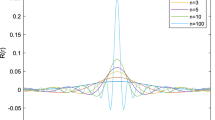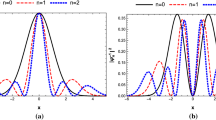Abstract
We numerically solve the functional differential equations (FDEs) of 2-particle electrodynamics, using the full electrodynamic force obtained from the retarded Lienard–Wiechert potentials and the Lorentz force law. In contrast, the usual formulation uses only the Coulomb force (scalar potential), reducing the electrodynamic 2-body problem to a system of ordinary differential equations (ODEs). The ODE formulation is mathematically suspect since FDEs and ODEs are known to be incompatible; however, the Coulomb approximation to the full electrodynamic force has been believed to be adequate for physics. We can now test this long-standing belief by comparing the FDE solution with the ODE solution, in the historically interesting case of the classical hydrogen atom. The solutions differ. A key qualitative difference is that the full force involves a ‘delay’ torque. Our existing code is inadequate to calculate the detailed interaction of the delay torque with radiative damping. However, a symbolic calculation provides conditions under which the delay torque approximately balances (3rd order) radiative damping. Thus, further investigations are required, and it was prematurely concluded that radiative damping makes the classical hydrogen atom unstable. Solutions of FDEs naturally exhibit an infinite spectrum of discrete frequencies. The conclusion is that (a) the Coulomb force is not a valid approximation to the full electrodynamic force, so that (b) the n-body interaction needs to be reformulated in various current contexts such as molecular dynamics.
Similar content being viewed by others
Reference
C. K. Raju, Time: Towards a Consistent Theory (Kluwer Academic, Dordrecht, 1994). (Fundamental Theories of Physics, Vol. 65.)
Preliminary versions of aspects of this paper have been circulating for some time, having been presented and discussed at various conferences and lectures over the past several years, e.g., "Simulating a tilt in the arrow of time: preliminary results," Seminar on Some Aspects of Theoretical Physics, Indian Statistical Institute, Calcutta, 14–15 May 1996, "The electrodynamic 2-body problem and the origin of quantum mechanics." Paper presented at the International Symposium on Uncertain Reality, New Delhi, 5–9 Jan 1998, "Relativity: history and history dependence." Paper presented at the On Time Seminar, British Society for History of Science, and Royal Society for History of Science, Liverpool, August 1999. "Time travel," invited talk at the International Seminar, Retrocausality Day, University of Groningen, September 1999, and in talks at the Universities of Southampton, Utrecht, Pittsburgh, etc.
Some attempts have been made to study the 2-body problem in 1 and 2-dimensions, and some approximation procedures have been suggested for three dimensions, but none of these are critically relevant to the question at hand. For a quick review see C. K. Raju, chap.Time: Towards a Consistent Theory (Kluwer Academic, Dordrecht, 1994) chap. 56. For the 1-body problem, see C. F. Eliezer, Rev. Mod. Phys. 19 147(1947): G. N. Plass, Rev. Mod. Phys. 33, 37–62. (1961) For the 2-body problem, see J. L. Synge, Proc. R. Soc. A177 118–139: (1940) R. D. Driver, Phys. Rev. 178 2051–2057, (1969) D. K. Hsing, Phys. Rev. D16 974–82; (1977) A. Schild, Phys. Rev. 131, 2762; (1963) C. M Anderssen and H. C. von Baeyer, Phys. Rev. D5, 802; (1972) Phys. Rev. D5, 2470; (1972). R. D. Driver, Phys. Rev. D19, 1098; (1979) L. S. Schulman, J. Math. Phys. 15, 205–208, (1974); K. L. Cooke and D. W. Krumme, J. Math. Anal. Appl. 24, 372–387; (1968). H. Van Dam and E. P. Wigner, Phys. Rev. 138B, 1576; (1965). 142, 838 (1966).
J. Andrew McCammon and Stephen C. Harvey, Dynamics of Proteins and Nucleic Acids (Cambridge University Press) 1987, p. 61.
David J. Griffiths, Introduction to Electrodynamics (Prentice Hall, India, 3rd edn. 1999, p. 435, Eq. (10.46). Cf. J. D. Jackson, Classical Electrodynamics, 3rd edn., (Wiley, 2001). Griffiths' book is more convenient for our purpose.
Griffiths, Electrodynamics, 3rd edn., Eqs. (10.65), (10.66) and (10.67), pp. 438-439.
Usually called just the Lorentz force law.
Griffiths, Electrodynamics, 3rd edn., 439, Eq. (10.67).
Griffiths, Electrodynamics, 3rd edn., p. 421. O. L. Brill and B. Goodman, Am. J. Phys. 35, 832, (1967).
C. K. Raju, Time: Towards a Consistent Theory (Kluwer Academic, Dordrecht 1994).chap. 5b.
L. E. El'sgol'tz, Introduction to the Theory of Differential Equations with Deviating Arguments, trans., R. J. McLaughlin (Holden-Day, San Francisco 1966), pp. 13-19.R. D. Driver, Introduction to Differential and Delay Equations (Springer, Berlin,1977).
C. K. Raju, Time: Towards a Consistent Theory (Kluwer Academic, Dordrecht 1994). chap. 5b.
C. K. Raju, Time: Towards a Consistent Theory (Kluwer Academic, Dordrecht 1994).
An earlier method suggested by Synge also assumes instantaneity, but it has the advantage that it can actually be implemented. This implementation will be considered in subsequent articles. See, J. L. Synge, J. R. Soc. A177 118–139, (1940).
El'sgol'tz, Differential Equations with Deviating Arguments, pp. 13-19. Driver, Differential and Delay Equations.
E. Hairer, S. P. Norsett and G. Wanner, Solving Ordinary Differential Equations (Springer Series in Computational Mathematics, Vol. 8) (Springer, Berlin, 1987; Revised edn. 1991.
El'sgol'ts, Differential Equations with Deviating Arguments, p. 9.
R. D. Driver, Differential and Delay Equations.
C. A. H. Paul, Numerical Analysis Report No. 283, Department of Mathematics, University of Manchester, 1995).
D. R. Willé and C. T. H. Baker, Appl. Num. Math. 9, 209-222 (1992).
Griffiths, Electrodynamics, 3rd edn., Eqs. (7.40) and (11.80), 326 and 467.
E. Hairer, S. P. Norsett, and G. Wanner, Solving Ordinary Differential Equations, cited above. (The above figures used the newer version of retard.).
P. A. M. Dirac, Proc. R. Soc. A 167, 148(1938). Also F. Rohrlich, Classical Charged Particles (Addison-Wesley, Reading, MA, 1985) p. 142.
Griffiths, Electrodynamics, 3rd edn., 11.80, p. 467.
El'sgol'tz, Differential Equations with Deviating Arguments, pp. 32-33.
El'sgol'tz, Differential Equations with Deviating Arguments, pp. 28-41.
C. K. Raju, "Simulating a tilt in the arrow of time," cited earlier. Such an approximation is a priori plausible, though there is, at present, no formal proof of its validity.
C. K. Raju, Time: Towards a Consistent Theory (Kluwer Academic, Dordrecht, 1994), Chap. 6
Author information
Authors and Affiliations
Rights and permissions
About this article
Cite this article
Raju, C.K. The Electrodynamic 2-Body Problem and the Origin of Quantum Mechanics. Foundations of Physics 34, 937–962 (2004). https://doi.org/10.1023/B:FOOP.0000034223.58332.d4
Issue Date:
DOI: https://doi.org/10.1023/B:FOOP.0000034223.58332.d4




